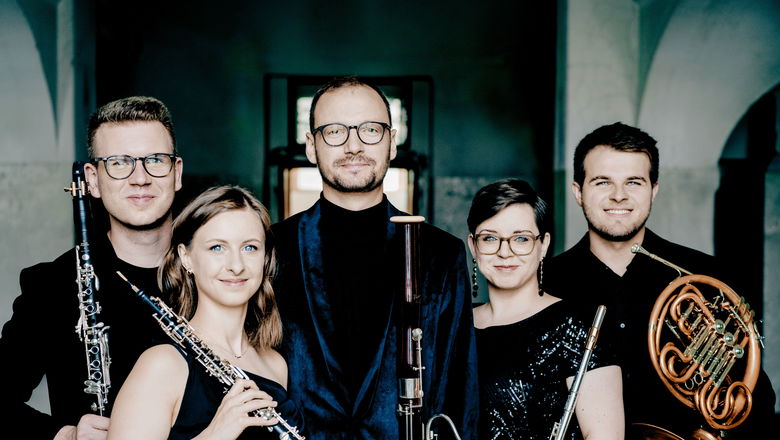1 / 6
Czech Chamber Music Society • Alinde Quintet
The Alinde Quintet has emerged in recent years as one of the finest Czech wind quintets. Their excellence was confirmed with a victory at the 2024 ARD International Music Competition. The ensemble will present original works and arrangements, with a focus on composers from the Nordic region.
Programme
Giuseppe Verdi (arr. by Joachim Linckelmann)
La forza del destino, overture to the opera (8')
Dmitri Shostakovich (arr. by Mark A. Popkin)
String Quartet No. 8 in C minor, Op. 110 (19')
— Intermission —
Pēteris Vasks
Wind Quintet No. 2 “Music for a Deceased Friend” (10')
Edward Grieg (arr. by David Walter)
Norwegian Dances, Op. 35 (15')
Performers
Alinde Quintet
Anna Talacková flute
Barbora Trnčíková oboe
David Šimeček clarinet
Petr Sedlák bassoon
Kryštof Koska French horn

Customer Service of Czech Philharmonic
Tel.: +420 227 059 227
E-mail: info@czechphilharmonic.cz
Customer service is available on weekdays from 9 a.m. to 6 p.m.
Performers
Alinde Quintet

Compositions
Giuseppe Verdi
La forza del destino, overture to the opera
The opera La forza del destino (The Force of Destiny) by Giuseppe Verdi (1813–1901) was commissioned by the Imperial Opera in Saint Petersburg following the success of his opera Il trovatore (The Troubadour) there. It is based on a Spanish drama from 1835 by Ángel de Saavedra. Its libretto is by Francesco Maria Piave who had already written eight operas for Verdi, including Macbeth, Rigoletto and La Traviata. It tells a story of a tragic love between a Spanish noblewoman and a young man of Inca background, which is ruined by class differences and prejudice. Piave extended Saavedra’s original with a scene from Friedrich Schiller’s trilogy of dramas Wallenstein. The premiere of this opera took place on October 29 (November 10) 1862 at the Imperial Grand Theater in Saint Petersburg, but the success of Il Trovatore was not repeated. A breakthrough came with La forza del destino in a new version to a libretto revised by Antonio Ghislanzoni, which was first performed on 27 February 1869 at La Scala in Milan. The main element of the overture is the strong motif of fate, which runs through the entire opera. In the past, various transcriptions and arrangements served to promote new compositions. This has enriched the concert repertoire because many such pieces became its permanent part, and this practice continues to this day. The German flutist Joachim Linckelmann (born 1964) has arranged large-scale choral and instrumental works, such as Verdi’s Requiem or Dvořák’s Stabat Mater, for chamber ensembles.
Dmitri Shostakovich
String Quartet No. 8 in C minor, Op. 110
String Quartet No. 8 in C minor, Op. 110, inscribed “In memory of victims of fascism and war”, was composed by Dmitri Shostakovich (1906–1975) in 1960. For almost 30 years, Shostakovich was being accused of “formalism” and considered to be “an artist alienated from the people” by critics from the highest echelons of power in the Soviet Union, but in the Western world he has since become one of the most important figures in 20th-century music. The political liberalization of the mid-1950s also changed Shostakovich’s situation: on 9 April 1960, he was elected secretary of the Union of Soviet Composers, and in September of the same year he was accepted as a candidate of the Communist Party. In the summer months between these two dates he stayed in Dresden and in a sanatorium in Saxon Switzerland, where he worked on music for the film Five Days, Five Nights. The film takes place in the aftermath of the bombing of Dresden at the end of the war. The impressions of the destruction of Dresden evoked in Shostakovich his own wartime memories of the devastated Leningrad, and so in a span of three days he composed String Quartet No. 8 to express grief over all the unnecessary victims of the war’s fury. It became a personal statement at this particular point in Shostakovich’s career. The String Quartet No. 8 opens with the acronym for the first four letters of Shostakovich’s name in German transliteration (DSCH – D, E flat, C, B natural; in German musical notation D, Es, C, H) that is repeatedly heard throughout the whole composition. String Quartet No. 8 consists of quotes from works by other composers as well as Shostakovich’s own music, such as the modified theme of his First Symphony, the second theme of his Fifth Symphony, or the theme of the final movement of his Piano Trio No. 2, derived from klezmer music as one of the distinctive elements of Shostakovich’s inspiration. The Scherzo is one of his typical grotesques in the rhythm of a demonic waltz, and the trio introduces another self-quote, this time from his Cello Concerto. String Quartet No. 8 also quotes revolutionary songs and Katerina Izmailova’s exclamations from Act 4 of the opera Lady Macbeth of Mtsensk, the performance of which in 1935 marked the beginning of Shostakovich’s politicized artistic struggle. The last two slow movements are among the most serious in Shostakovich’s oeuvre. The funeral march motif returns, and the piece closes with a fugue. String Quartet No. 8 was first performed on 2 October 1960 in Leningrad by the Beethoven Quartet, an ensemble with which the composer collaborated from 1940 until the end of his life. It was arranged by American bassoonist Mark Anthony Popkin (1929–2011), who also scored other pieces for string quintet, for example, Antonín Dvořák’s String Serenade, Op. 22.
Pēteris Vasks
Wind Quintet No. 2 “Music for a Deceased Friend”
Latvian composer Pēteris Vasks (*1946) is one of the leading representatives of contemporary music from the Baltic states. In addition to inspiration from Latvian folklore, the impulses that contributed to the search for his own compositional style included the music by Witold Lutosławski and Krzysztof Penderecki. Vasks has composed works in a variety of genres. His Music for a Deceased Friend has autobiographical features. It was written in 1981 and is dedicated to the memory of Jana Barinska, who perished tragically during a fire. The primary building block of the piece is the interval of an
ascending third and a descending second as a harbinger of danger. The motif develops like the outbreak and spread of fire and becomes quiet in silent resignation. The composition is reminiscent of ancient Latvian funeral songs. The musical flow is interrupted by sighs and screams; Vasks also includes the human voice. The composition ends in complete silence.
Edvard Grieg
Norwegian Dances, Op. 35
A basic characteristic of the oeuvre of Edvard Hagerup Grieg (1843–1907) is his inspiration from Norwegian folk music. In his piano works, consisting of numerous sets and cycles, Grieg drew heavily on traditional melodies and rhythms. The four Norwegian Dances, Op. 35, from 1881, exist in a two-hand piano version as well as in a version for piano four hands. For these, Grieg used original folk melodies from the collection Norske Fjeldmelodier compiled and published by Ludvig Mathias Lindeman (1812–1887). All four dances are in three sections. The first dance, known as the “Sinclair March”, is based on a song from the mountains in the north of Norway, supposedly forming part of the cultural memory of the population which once came to this region from Scotland. The dance, charged with energy, has a lyrical central section; one of the typical elements of Grieg’s style is the ostinato bass. The other three dances are “hallings”. A halling is a traditional Norwegian dance in 2/4 or 6/8 beat, in which men perform an acrobatic dance to impress young women to the accompaniment of an eight-string fiddle resonating with a peculiar buzzing sound. In the second dance, a simple melody with a syncopated rhythm is modulated by a virtuoso middle section in C sharp minor. In the third dance, the contrast is provided by a quiet middle section with sharp dynamic twists. The fourth dance opens with a short slow introduction, followed by a lively rhythmic section and a reverie in a minor key with rich harmonic modulations; the recapitulation of the energetic section ends with a coda. Norwegian Dances also have an orchestral version, created in 1891 by Czech violinist, conductor and composer Hans (Jan) Sitt. The arrangement for wind quintet is by French oboist, composer and arranger David Walter (*1958).